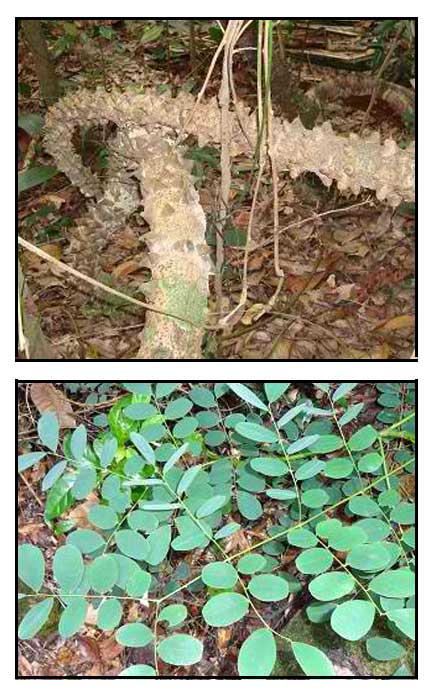 Botany Botany
Siit is a robust, prickly climber, 6 to 10 meters in length. Leaves are compound, 30 centimeters or more in length. Pinnae are 6, about 10 centimeters long. Leaflets are firm, smooth, oblong or obovate-oblong, 5 to 8 centimeters in length, 2.5 to 3.5 centimeters wide. Racemes are forked, as long as the leaves, hairy and obtuse at the tip. Calyx is smooth, 1 to 1.3 centimeters long, with the upper teeth minute, the lowest longer, and the tube splitting at the insertion of the glabrous filaments. Petals are a little exserted, reddish-yellow, permanently imbricated and oblanceolate-spatulate. Pods are thin, about 15 centimeters long, 4 to 5.5 centimeters wide, furnished with a moderately broad wing, containing 4 to 5 seeds.
Distribution
- Found in thickets, at low altitudes in Palawan.
- Also known to occur in Sumatra, Borneo, Singapore and the Malay Peninsula.
Constituents
- The active substance is a saponin.
- Leaf and bark yield a weak alkaloid.
- Phytochemical screening of various extracts (n-hexane, chloroform, ethyl acetate and ethanol) yielded alkaloid, flavonoid, coumarin, and carotenoid, with absence of tannin, saponin, and steroids. All extracts yielded alkaloid and flavonoid. (see study below) (2)
Properties
- Considered vermifuge, antidiabetic.
- Studies have suggested antioxidant, antidiabetic properties.
Parts
utilized
Leaves.
Uses
Folkloric
- The Malays use a decoction of leaves used as a vermifuge and for intestinal complaints like diarrhea.
- Also used after childbirth.
- Local tribes in East Kalimantan, Indonesia use the plant for treatment of diabetes. (2)
Studies
• Antidiabetic / Antioxidant: Study evaluated various extracts i.e., n-hexane, chloroform, ethyl acetate and ethanol, to evaluate for antioxidant and antidiabetic potential. All extracts yielded alkaloid and flavonoid. The ethanol extract exhibited highest antioxidant activity of 82.32% with IC50 of 5.00 µg/ml. The EE also showed a-glucosidase inhibitory activity with IC50 of 17.16 µg/ml and a-amylase inhibitory activity with IC50 of 16.78 µg/mL. Results suggest potential for a natural antidiabetic and antioxidant agent. (2)
Availability
Wild-crafted. |

![]()

